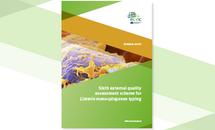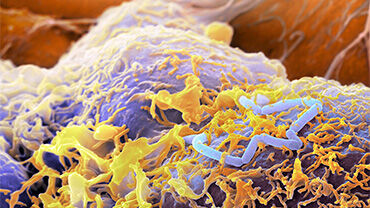Sixth external quality assessment scheme for Listeria monocytogenes typing
This report presents the results of the sixth round of the external quality assessment (EQA-6) scheme for Listeria monocytogenes (L. monocytogenes) typing organised for laboratories providing data to the Food- and Waterborne Diseases and Zoonoses Network (FWD-Net) managed by ECDC.
Executive Summary
Since 2012, the Section for Foodborne Infections at Statens Serum Institut (SSI) in Denmark has arranged the EQA under a framework contract with ECDC. EQA-6 contains serotyping and molecular typing-based cluster analysis.
Human listeriosis is a relatively rare but serious zoonotic disease with an EU notification rate of 0.48 cases per 100 000 population in 2017 [3]. The number of human listeriosis cases in the EU has increased since 2008, with a peak in the annual number in 2016 of 2 509.
Since 2007, ECDC’s FWD Programme has been responsible for the EU-wide surveillance of listeriosis, including facilitating, detecting and investigating foodborne outbreaks. Surveillance data, including basic typing parameters for the isolated pathogen, are reported by Member States to The European Surveillance System (TESSy), including molecular typing data. This molecular surveillance system relies on the capacity of laboratories providing data to FWD-Net to produce comparable typing results. In order to ensure the EQA is linked to the development of surveillance methods used by public health national reference laboratories in Europe, EQA-6 contains a molecular typing-based cluster analysis using either pulsed-field gel electrophoresis (PFGE) and/or whole-genome sequencing (WGS)-derived data.
The objectives of the EQA are to assess the quality and comparability of typing data reported by public health national reference laboratories participating in FWD-Net. Test isolates for the EQA were selected to cover isolates currently relevant to public health in Europe and represent a broad range of clinically relevant types for invasive listeriosis. Two separate sets of 11 test isolates were selected for serotyping and molecular typing-based cluster analysis. Eighteen laboratories signed up and 17 completed the exercise, representing a decrease in participation of 15% from the previous assessment (EQA-5) and an even larger decrease from EQA-4 of 26%. The decrease in the number of participants may have been caused by adding WGS or removing PFGE as an independent part. The majority (65%) of participants completed the full EQA scheme. In total, 13 (77%) participants participated in the serotyping part and 15 (88%) in the molecular typing-based cluster analysis.
Molecular serotyping results were provided by all 13 (100%) participants. Only four participants performed both conventional and molecular serotyping. The performance of conventional serotyping was highest, with 100% correct results. A total of 77% of the respective participants correctly serotyped all test isolates by molecular method. Since the first EQA in 2012, a trend towards substituting conventional serotyping with molecular serotyping has been observed as none of the participants exclusively performed conventional serotyping in EQA-6.
Of the 17 laboratories participating in EQA-6, 15 (88%) performed molecular typing-based cluster analysis using any method. The idea of the cluster analysis part of the EQA was to assess the public health national reference laboratories’ ability to identify a cluster of genetically closely related isolates given that a multitude of different laboratory methods and analytical methods are used as the primary cluster detection approach in Member States. This part of the EQA was atypical in the sense that the aim was to assess the participants’ ability to reach the correct conclusion, i.e. to correctly categorise the cluster test isolates, not to follow a specific procedure.
The cluster of closely related isolates contained seven ST399 isolates that could be identified by PFGE- (by either Apa I or Asc I profiles). The correct WGS cluster contained five ST399 isolates. The expected cluster was based on a predefined categorisation by the organiser. Seven laboratories used PFGE for cluster analysis and four of them also reported cluster analysis based on WGS data. Only one laboratory did not identify the correct cluster using PFGE.
Twelve laboratories performed cluster analysis using WGS-derived data. Performance was high, with 11/12 (92%) of the participants correctly identifying the cluster of closely related isolates. An allele-based method was preferred since 75% (9/12) used core genome multilocus sequence type (cgMLST), compared with 25% (3/12) using single nucleotide polymorphism (SNP). Only one laboratory did not identify the correct cluster, but included additional two isolates. The results were based on a SNP analysis.
In the EQA, participants were free to choose their preferred analytical method for the WGS-based cluster identification. The conclusion from EQA-5 showed cgMLST to have higher consistency compared to SNP analysis. The conclusion was not as obvious this year since only three SNP analyses were reported in EQA-6 compared with six in EQA-5. Comparing cgMLST result of Illumina and Ion Torrent data revealed differences, which suggest lower inter-laboratory comparability across sequencing platforms.
Download






